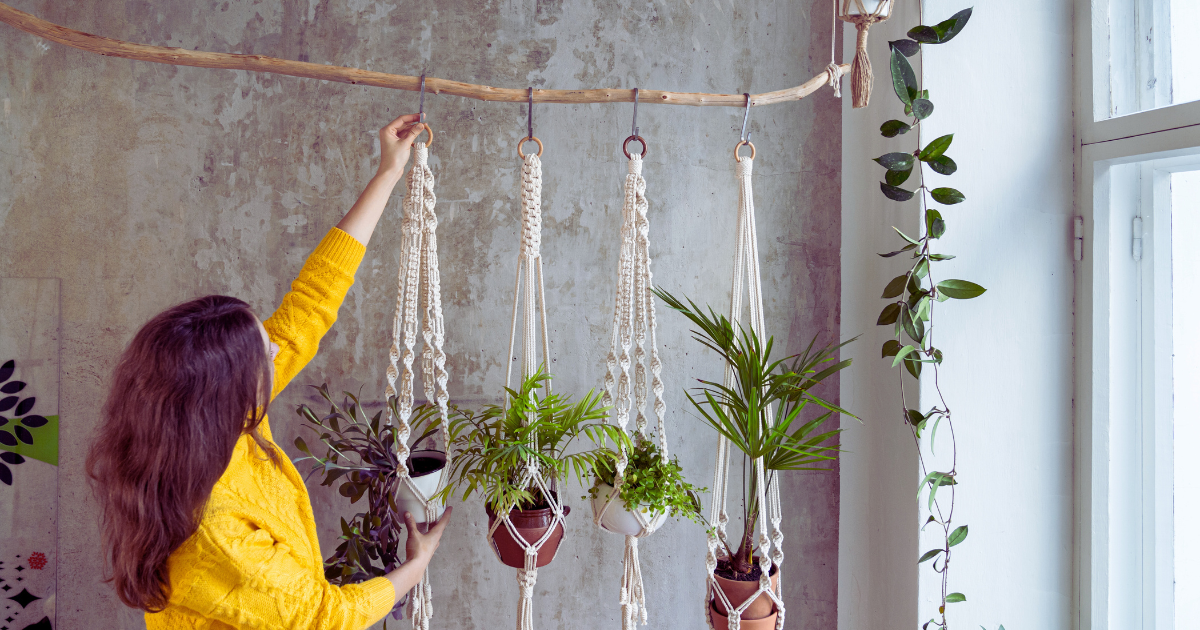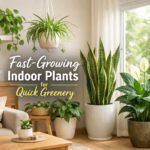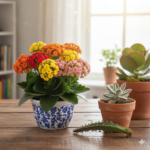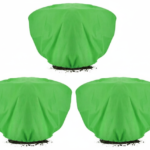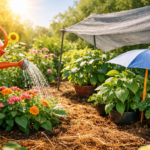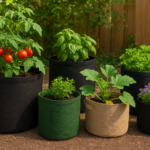Hanging plants offer a charming and innovative way to introduce greenery into your home, whether short on space or simply looking to add a unique touch to your décor. These suspended botanical wonders can transform any room into a vibrant oasis, bringing beauty and air-purifying benefits. From cascading vines to lush ferns, the variety of plants suitable for hanging is vast, allowing you to create stunning visual displays. In this guide, we’ll explore the ins and outs of hanging plants from the ceiling, covering everything from selecting the perfect plants to ensuring their proper care. Whether you’re a seasoned plant enthusiast or a beginner, you’ll find practical tips and creative ideas to help you maximize your hanging garden.
So, let’s dive in and discover how to elevate your indoor greenery!
Can hanging plants improve indoor air quality?
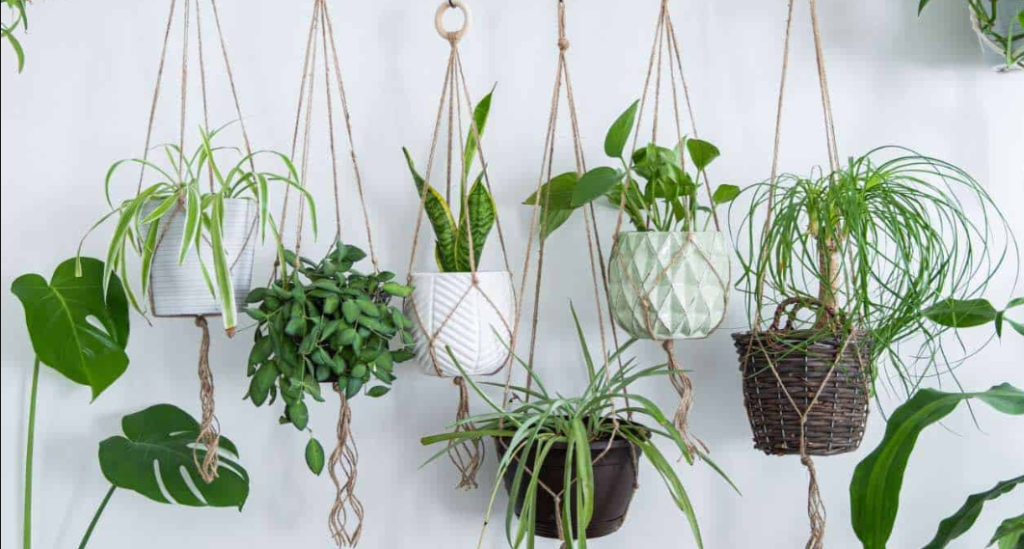
Hanging plants can significantly improve indoor air quality by acting as natural air purifiers. They absorb harmful pollutants, such as volatile organic compounds (VOCs) found in household products and materials, and release oxygen, enhancing the overall air quality.
Plants like spider plants, peace lilies, and pothos are particularly effective at filtering toxins like formaldehyde, benzene, and carbon monoxide. Additionally, plants increase humidity through transpiration, which can alleviate respiratory issues and reduce the prevalence of airborne dust. Beyond their physical benefits, the presence of plants can also improve mental well-being, reduce stress, and create a more pleasant living environment. Thus, incorporating hanging plants into your indoor spaces beautifies your home and contributes to a healthier and more refreshing atmosphere.
Types of Hanging Planters
Choosing the correct type of hanging planter can significantly enhance the aesthetic and functionality of your indoor garden. Here are three popular types, each offering unique styles and benefits:
1.Macrame Plant Hangers
Macrame plant hangers are a trendy and decorative way to display hanging plants. Made from knotted cords, they can be crafted from various materials such as cotton, jute, or hemp. The intricate designs of macrame hangers add a bohemian or rustic charm to any space.
- Aesthetic Appeal: Macrame hangers come in various patterns and colors, allowing you to match them with your home decor. They add a handmade, artisanal touch to your plant display.
- Versatility: These hangers are versatile and can hold a variety of pot sizes and shapes. They are ideal for small to medium-sized pots.
- Space-Saving: Macrame hangers are great for small spaces as they utilize vertical space effectively.
2.Hanging Baskets
Hanging baskets are a classic choice for displaying plants. They come in various materials, including metal, plastic, and wicker. They are trendy for outdoor spaces like patios and balconies but can also be used indoors.
- Material Variety: You can choose from various materials offering different looks and benefits. For instance, metal baskets are durable and modern, while wicker baskets provide a natural, earthy feel.
- Liners: Many hanging baskets come with liners made from materials like coco coir, which helps retain moisture and prevent soil from spilling out.
- Drainage: Hanging baskets often have built-in drainage holes that prevent water from accumulating and causing root rot.
3.Wall-Mounted Planters
Wall-mounted planters are an excellent option for displaying plants with limited floor or ceiling space. These planters are attached directly to the wall and can be used to create stunning vertical gardens.
- Space Efficiency: Wall-mounted planters make the most of vertical space, allowing you to grow plants in unused areas.
- Design Options: These planters can be arranged to create eye-catching displays in various designs, from simple pots to elaborate wall grids.
- Accessibility: Unlike hanging baskets or macrame hangers, wall-mounted planters are easier to access for watering and maintenance. They are ideal for herbs, succulents, and other small plants.
Each type of hanging planter offers distinct advantages, so you can choose based on your space, style preferences, and the specific needs of your plants. Whether you opt for the intricate charm of macrame, the classic appeal of hanging baskets, or the space-saving benefits of wall-mounted planters, you’ll add a beautiful and practical element to your home.
Best Plant Varieties for Hanging

When choosing plants to hang from the ceiling, selecting species that thrive in elevated positions and are easy to care for is essential. Here are some of the best plant varieties for hanging:
- Pothos (Epipremnum aureum)
- Pothos is a popular choice for hanging baskets due to its hardiness and attractive trailing vines. It can tolerate low light conditions and requires minimal maintenance, making it perfect for beginners.
- Spider Plant (Chlorophytum comosum)
- Known for its air-purifying properties, the spider plant is an excellent choice for hanging. Its arching leaves and small plantlets that dangle from the mother plant create a beautiful display. The spider plant thrives in indirect light and needs regular watering.
- Philodendron
- Philodendrons come in many varieties, such as the heartleaf philodendron, perfect for hanging. They are low-maintenance and can adapt to various light conditions, although they prefer bright, indirect light.
- String of Pearls (Senecio rowleyanus)
- This unique succulent is known for its bead-like leaves cascading down the planter’s sides. It’s ideal for hanging baskets in well-lit areas. The string of pearls requires minimal watering, making it an excellent option for those who may forget to water frequently.
- English Ivy (Hedera helix)
- English Ivy is a versatile plant that can be trained to trail down or climb up a trellis. It’s an excellent choice for hanging planters, especially in bright, indirect light. Regular watering and occasional pruning help keep it looking lush.
- Boston Fern (Nephrolepis exaltata)
- Boston ferns are perfect for adding a lush, tropical feel to any space. They thrive in high humidity and indirect light and are ideal for bathrooms or kitchens. Regular misting and watering are essential to keep them healthy.
- Hoya (Hoya spp.)
- Often called the “wax plant” due to its waxy leaves and fragrant flowers, Hoya is a fantastic choice for hanging. It prefers bright, indirect light and moderate watering, making it a relatively low-maintenance plant.
Best Plants for Air Purification
While many plants offer air-purifying benefits, some are particularly effective at improving indoor air quality. Here are a few examples:
- Snake Plant (Sansevieria): Known for its ability to absorb formaldehyde and benzene, it continues producing oxygen even at night.
- Peace Lily (Spathiphyllum): Excellent at removing VOCs like benzene and formaldehyde, and its white blooms add elegance.
- Boston Fern (Nephrolepis exaltata): Great for increasing humidity and absorbing formaldehyde.
- English Ivy (Hedera helix): Effective at reducing airborne mold and toxins.
How to Choose the Right Plants for Hanging?

Selecting the right plants for hanging can significantly enhance your indoor or outdoor space. The key is considering various factors to ensure the plants thrive in their new environment. Here’s a guide to help you make the best choices:
Consider the Light Conditions
- Bright Light: Some plants, like succulents and cacti, thrive in bright, direct sunlight. Consider options like String of Pearls or Hoya if you have a sun-soaked area.
- Indirect Light: Many hanging plants prefer indirect light, which is less intense. Pothos, spider plants, and philodendrons are excellent choices for bright, indirect light spaces.
- Low Light: If you’re working with a dimmer space, choose plants like snake plants or ZZ plants that can tolerate low light conditions.
Assess the Space and Growth Habit
- Vertical Space: Consider your vertical space. Some plants, like Boston ferns or ivy, can grow long and require trimming or a larger area to spread.
- Horizontal Spread: Ensure the plant has enough room to spread out horizontally. This is especially important for fuller plants like ferns or trailing philodendrons.
Evaluate the Maintenance Level
- Low-Maintenance Plants: If you prefer low-maintenance options, go for hardy plants like pothos or spider plants, which require minimal care.
- High-Maintenance Plants: For those willing to invest more time, plants like Boston ferns or certain varieties of orchids can offer stunning displays but require more attention.
Consider Humidity and Temperature
- Humidity: Some plants, such as ferns, thrive in high-humidity environments. These are great for kitchens or bathrooms. Consider adding a humidifier or placing a water tray nearby if your space is dry.
- Temperature: Ensure the plant’s temperature preferences match your indoor climate. For example, tropical plants like hoyas prefer warmer temperatures.
Check for Toxicity
- Pet and Child Safety: Some plants can be toxic if ingested by pets or children. If you have pets or young children, research the toxicity of the plants you’re considering and opt for non-toxic varieties like spider plants.
Aesthetic Preferences
- Color and Texture: Consider the plants’ colors and textures. Variegated leaves, flowering varieties, or uniquely textured plants can add a dynamic element to your space.
- Theme and Style: Match the plants with your decor’s overall theme and style. A plant fits the bill whether you prefer a tropical, minimalist, or bohemian look.
Materials and Tools Needed
You’ll need a few essential materials and tools to hang plants from the ceiling successfully. Here’s a list of what you’ll need, along with details on each item:
Hanging Planters
- Types: Choose from various hanging planters such as macrame hangers, metal baskets, or ceramic pots. The kind you choose should complement your interior design and suit the plant’s size and weight.
- Size: Ensure the planter is large enough to accommodate the plant’s root system but not so large that it becomes too heavy to hang securely.
Hooks and Ceiling Anchors
- Ceiling Hooks: These are essential for suspending your plants from the ceiling. Options include screw hooks, swag hooks, and adhesive hooks. Screw hooks are the most secure.
- Anchors: If attaching hooks to drywall or plaster, use anchors to ensure the hook can support the plant’s weight. Toggle bolts are ideal for heavier plants.
Drill and Drill Bits
- Drill: A power drill is necessary to create holes in the ceiling for hooks or anchors.
- Drill Bits: Choose drill bits that match the size of your anchors or hooks. A masonry bit may be needed for concrete ceilings.
Measuring Tape and Level
- Measuring Tape: Use this to determine the length of the plant’s drop and to ensure the hooks are spaced appropriately.
- Level: A level helps ensure your hanging plants are straight, adding to the aesthetic appeal.
S-hooks or Carabiners
- S-hooks: These are useful for hanging planters from hooks and can make it easier to adjust the height.
- Carabiners are particularly useful for heavier plants or when you need a more secure connection. They also allow for easy removal of the planter for watering or maintenance.
Rope, Chains, or Wire
- Rope: Natural fibers like jute or cotton are famous for their rustic look. Ensure the rope is strong enough to support the plant’s weight.
- Chains: Metal chains offer a more industrial look and are very durable.
- Wire: Thin, strong wire suits lighter plants and provides a minimalist appearance.
Safety Glasses and Gloves
- Safety Glasses: Protect your eyes while drilling into the ceiling.
- Gloves: Wear gloves to protect your hands from sharp edges and to improve your grip when handling tools and materials.
Watering Tools
- Watering Can: A long-spout watering can is ideal for reaching hanging plants.
- Spray Bottle: Useful for misting plants that require high humidity.
Plant Care Supplies
- Soil: Choose a well-draining potting mix suitable for your specific plants.
- Fertilizer: Use a balanced fertilizer to keep your plants healthy.
- Pest Control: Consider natural pest control options like neem oil.
Safety Considerations
When incorporating hanging plants into your home, safety is paramount. Ensure you use heavy-duty hooks and anchors that can support the weight of your plants and planters. Locating ceiling joists or using appropriate wall anchors to secure them properly is crucial. Regularly inspect all components, such as chains, ropes, and hooks, for signs of wear or damage and replace them as needed. Avoid placing hanging plants in high-traffic areas or above beds and seating to prevent accidents.
Additionally, if you have children or pets, choose non-toxic plants and hang them out of reach. Proper watering techniques, like using drip trays, can help prevent water damage or slips. By following these safety measures, you can enjoy the beauty and benefits of hanging plants while ensuring a secure and hazard-free environment.
- Choosing the Right Location
- Optimal Light Conditions
- Assessing Ceiling Strength and Accessibility
- Installation Techniques
- Using Ceiling Hooks
- Anchors and Toggle Bolts
- DIY Hanging Rods
- Step-by-Step Guide to Hanging Plants
- Preparing Your Plant and Planter
- Installing Hooks and Anchors
- Securing the Planter
Read the review to know: Umbra Triflora Hanging Planter for Window, Indoor Herb Garden Review 2024
Tips for Creating a Hanging Garden

Creating a hanging garden is a fantastic way to maximize vertical space and add greenery to your home or outdoor area. Whether you’re aiming for a lush indoor jungle or a vibrant outdoor display, here are some tips to help you design and maintain a beautiful hanging garden:
Plan Your Space
- Assess Available Space: Consider where you want to create your hanging garden. Look at the ceiling height, wall space, and potential places for hooks or brackets. This will help you decide how many plants you can accommodate and where to place them.
- Lighting Conditions: Identify the natural light available in the area. Choose plants that match the light conditions—bright, indirect, low light, or full sun. For areas with limited natural light, consider using grow lights.
Choose the Right Plants
- Variety and Texture: Mix different plant varieties and textures for visual interest. Combine trailing plants like pothos with bushier varieties like ferns or upright plants like snake plants.
- Size and Growth Rate: Select plants that suit the scale of your space and consider their growth rates. Fast-growing plants need more frequent pruning or larger pots over time.
- Climate and Care Needs: Pick plants suitable for your local climate, especially if your hanging garden is outdoors. Ensure that the plants’ care needs (watering, humidity, temperature) are similar to make maintenance easier.
Select Appropriate Planters
- Diverse Planters: To create a dynamic display, use a variety of planters, such as macrame hangers, baskets, and wall-mounted pots. Ensure they complement each other and the overall aesthetic.
- Drainage: Make sure all planters have proper drainage to prevent waterlogging. Consider using saucers or trays to catch excess water.
Installation and Arrangement
- Sturdy Installation: Use strong hooks, anchors, and brackets to support the weight of the plants and planters. Test the stability before hanging the plants.
- Layering and Grouping: Hang plants at different heights to create depth and visual interest. Group plants with similar care needs together, and consider creating clusters or rows for a cohesive look.
- Accessibility: Arrange the plants so they are easy to water and maintain. Avoid placing plants too high or in hard-to-reach areas.
Creative Accents
- Decorative Elements: To enhance the aesthetic of your hanging garden, add decorative elements like fairy lights, decorative stones, or small sculptures.
- Color Coordination: Coordinate the colors of the planters, plants, and decorative elements to create a harmonious look.
Experiment and Evolve
- Try Different Arrangements: Don’t be afraid to experiment with different arrangements and plant combinations. You may need to rearrange your plants to suit their changing needs as they grow.
- Adapt to Seasons: If your hanging garden is outdoors, consider rotating plants or changing the arrangement based on seasonal changes.
How to Secure Heavy Plants?
Securing heavy plants is essential to ensure their safety and stability, especially when hanging them from the ceiling or placing them on shelves. Proper installation and support prevent accidents and protect your plants and home. Here are some tips to help you securely hang or place heavy plants:
Choose the Right Hooks and Anchors
- Heavy-Duty Hooks: Use heavy-duty ceiling hooks designed to support substantial weight. To ensure safety, look for hooks rated for at least twice the weight of your plant and planter.
- Anchors for Drywall or Plaster: If you attach hooks to drywall or plaster, use appropriate anchors such as toggle bolts or molly bolts. These provide additional support and prevent the hooks from pulling out under the plant’s weight.
- Stud Finders: Use a stud finder to locate the strongest points on ceiling joists, where you should attach your hooks. Securing hooks directly into joists is the safest option for heavy plants.
Use Strong Hanging Materials
- Chains: Metal chains are solid and durable, ideal for supporting heavy plants. Ensure the chains are securely attached to both the hook and the planter.
- Rope: If using rope, choose a thick, sturdy type, like nylon or braided cord, that can handle the weight. Double-check the rope’s weight rating before using it.
- Carabiners and S-hooks: Use carabiners or heavy-duty S-hooks to connect the chains or ropes to the hooks. These allow for easy installation and adjustment while providing a secure connection.
Select Sturdy Planters
- Material: Choose planters made from durable materials like metal, heavy-duty plastic, or reinforced ceramic. These materials can support the weight of the soil and plant without cracking or breaking.
- Size: Ensure the planter is appropriately sized for the plant’s root system. A pot that is too small can tip over, while one that is too large can be unnecessarily heavy.
Ensure Proper Distribution of Weight
- Balance: Distribute the weight evenly across the support points. If using multiple hooks or chains, ensure the load is evenly shared to prevent stress at any moment.
- Center of Gravity: Hang the plant so its center of gravity is directly below the hook or support point. This prevents the planter from tipping or swaying excessively.
Secure Wall-Mounted Planters
- Sturdy Brackets: For wall-mounted planters, use sturdy brackets rated for the weight of the plants and soil. Ensure the brackets are securely fastened into wall studs or use appropriate wall anchors.
- Regular Checks: Periodically check the brackets’ stability and the wall’s condition, significantly if the plants are watered frequently.
Consider a Safety Chain or Wire
- Safety Chain: Add a secondary safety chain or wire as a backup if the primary support fails. This is especially important for burdensome plants or areas with much movement, such as outdoor patios.
- Regular Inspection: Inspect all components for signs of wear, corrosion, or damage. Replace any compromised parts immediately to maintain safety.
Floor Placement Considerations
- Sturdy Stands: If placing heavy plants on shelves or stands, ensure the furniture is strong enough to support the weight. Plant stands with a low center of gravity should be used to reduce the risk of tipping.
- Non-Slip Pads: Place non-slip pads under pots or planters to prevent them from sliding, especially on smooth surfaces.
Tips for Maintaining Indoor Hanging Plants
Maintaining indoor hanging plants can be a delightful experience, as they bring life and beauty to any room. However, they require proper care to thrive. Here are some essential tips to help you keep your indoor hanging plants healthy and vibrant:
Watering
- Consistent Schedule: Establish a regular watering routine based on the specific needs of your plants. Most hanging plants prefer to be watered when the top inch of soil feels dry.
- Check for Drainage: Ensure your hanging planters have proper drainage to prevent water from pooling at the bottom, which can lead to root rot. If your planter doesn’t have drainage holes, consider using a pot liner with holes.
- Watering Technique: Use a watering can with a long spout to reach hanging plants easily. Water thoroughly until you see excess water draining out of the bottom. Empty any saucers or trays under the plants to prevent waterlogging.
Light Requirements
- Assess Light Conditions: Different plants have varying light needs. Place your plants according to their specific requirements—bright, indirect light, low light, or direct sunlight.
- Rotate Plants: Rotate your hanging plants regularly to ensure all sides receive adequate light, promoting even growth.
Humidity and Temperature
- Humidity: Many indoor plants, especially tropical varieties, thrive in higher humidity. Increase humidity by misting the plants, using a humidifier, or placing a water tray nearby.
- Temperature: Keep plants away from drafts, heaters, or air conditioners, as sudden temperature changes can stress the plants. Maintain a consistent room temperature suitable for your plant type.
Fertilization
- Balanced Fertilizer: Use a balanced, water-soluble fertilizer to feed your plants during the growing season (spring and summer). Follow the instructions on the fertilizer package to avoid over-fertilizing, which can damage the roots.
- Frequency: Typically, fertilizing every 4-6 weeks is sufficient, but this can vary depending on the plant species.
Pruning and Grooming
- Remove Dead or Yellowing Leaves: Regularly check for and remove dead or yellowing leaves to keep the plant healthy and prevent disease spread.
- Pruning: Trim back any overgrown or leggy stems to encourage bushier growth and maintain the plant’s shape. Use clean, sharp scissors or pruning shears.
Pest Control
- Regular Inspection: Inspect your plants regularly for signs of pests such as aphids, spider mites, or mealybugs. Early detection is crucial for effective treatment.
- Natural Remedies: Use natural pest control methods like neem oil and insecticidal soap or introduce beneficial insects to manage infestations. Avoid harsh chemical pesticides, especially indoors.
Repotting
- Report When Necessary: As plants grow, they may outgrow their containers. Report your hanging plants every 1-2 years or when they become root-bound. Choose a pot slightly larger than the current one and use fresh potting soil.
- Gently Handle Roots: Be gentle when handling the roots during repotting to avoid damaging them.
Dusting
- Clean Leaves: Dust can accumulate on the leaves of indoor plants, reducing their ability to photosynthesize. Gently wipe the leaves with a damp cloth to keep them clean and healthy.
Creative Ideas for Displaying Hanging Plants
Grouping Plants for Aesthetic Appeal
Grouping hanging plants can create a visually appealing display. By mixing different types of plants, such as ferns, succulents, and flowering varieties, you can add texture and color to your space. Arrange plants at varying heights to create depth and interest. This technique enhances the aesthetic appeal and allows you to showcase different plant species in a cohesive arrangement.
Creating a Hanging Garden
A hanging garden can transform any space into a green oasis. To create variety, use different types of planters, such as macramé hangers, wire baskets, or ceramic pots. Consider each plant’s light requirements to ensure it thrives in its new home. A well-planned hanging garden can be a focal point in a room, adding beauty and functionality.
Using Shelves and Racks
Shelves and racks are practical solutions for displaying hanging plants, especially in small spaces. They allow you to utilize vertical space effectively, making more plants available. Wooden or metal racks can be customized to fit any decor style, and shelves can be arranged in creative patterns to add a unique touch. This method makes it easier to care for your plants, as they are more accessible for watering and maintenance.
FAQ
What are the best plants for hanging indoors?
The best indoor hanging plants include pothos, spider plants, ferns, and trailing varieties like string of pearls or ivy. These plants are easy to care for and thrive in various indoor environments.
How do I ensure my ceiling can support the weight of hanging plants?
Use sturdy hooks or anchors designed explicitly for hanging plants to ensure your ceiling can support the weight. Check the load capacity and choose hooks that can handle at least double the weight of your heaviest plant to ensure safety.
How often should I water my hanging plants?
Watering frequency depends on the plant type, potting mix, and indoor conditions. Generally, hanging plants should be watered when the top inch of soil feels dry. Be sure to allow excess water to drain to prevent root rot.
Can I hang plants in low-light areas?
Yes, you can hang plants in low-light areas. Choose low-light-tolerant plants like snake plants, pothos, or philodendrons. If necessary, consider supplementing natural light with artificial grow lights.
How do I deal with pests in hanging plants?
To deal with pests, regularly inspect your hanging plants for signs of infestation. Use natural remedies like neem oil or insecticidal soap to treat common pests such as aphids, spider mites, and mealybugs. Maintaining proper plant care and hygiene can also help prevent infestations.
Conclusion
Incorporating hanging plants into your home decor offers a fresh and vibrant aesthetic. Grouping plants enhances visual appeal while creating a hanging garden that brings a touch of nature indoors. Utilizing shelves and racks maximizes space and adds a unique, customizable element to your design. These creative ideas beautify your living space and provide a calming, green ambiance. Embrace these techniques to transform your home into a stylish and verdant sanctuary.

